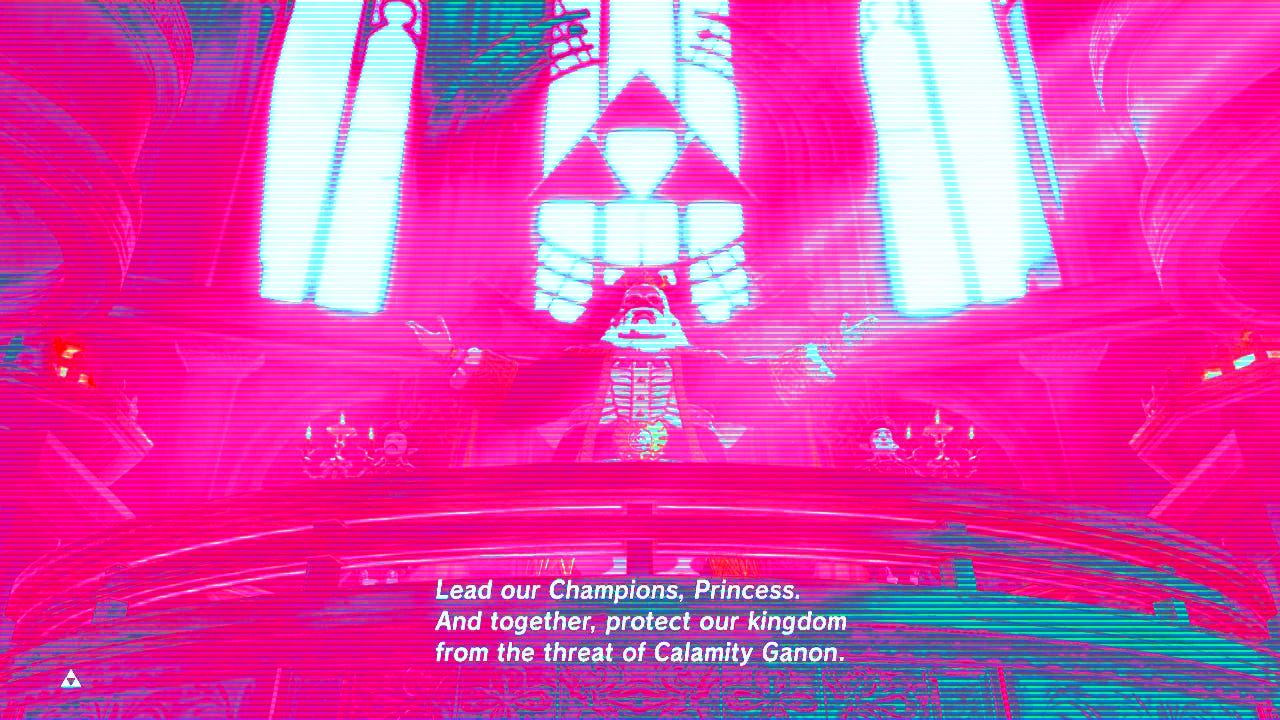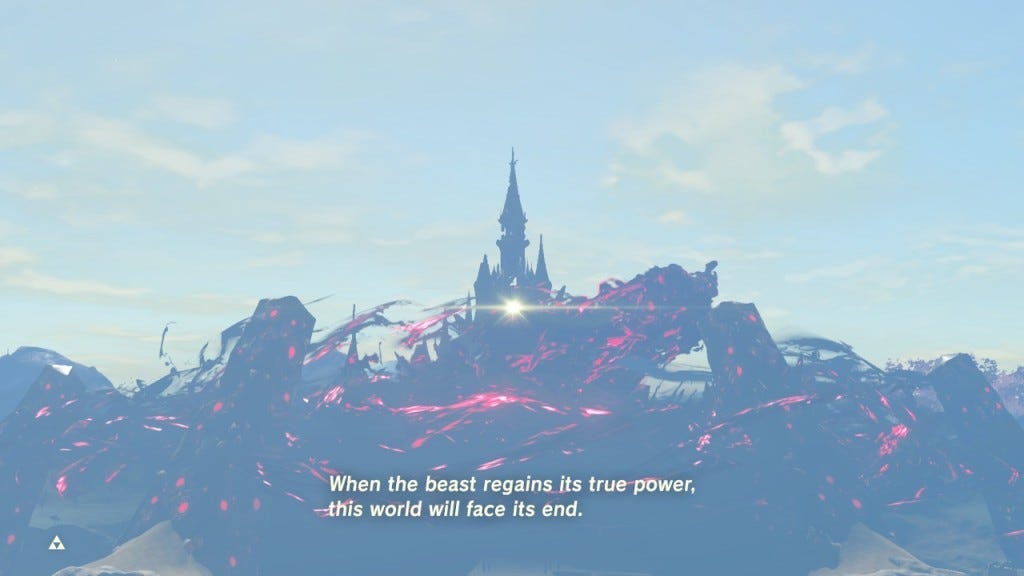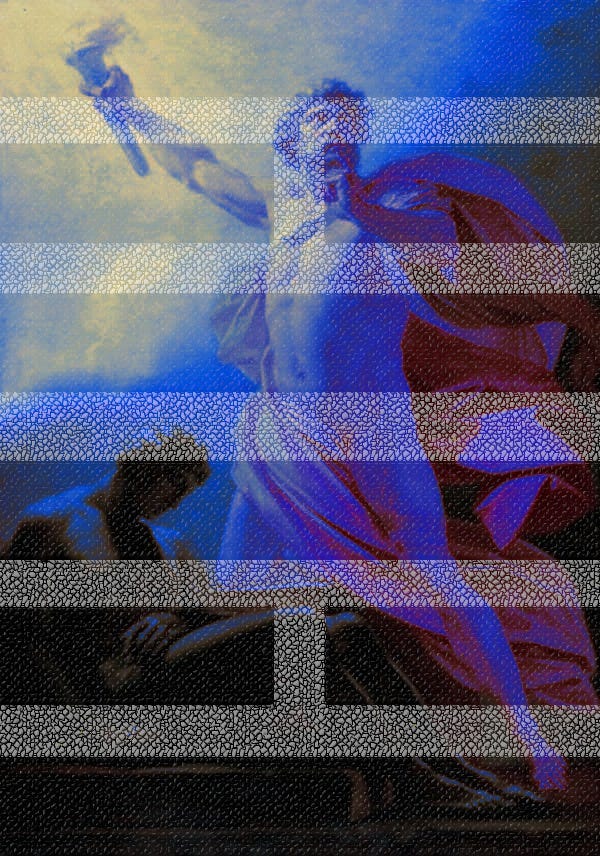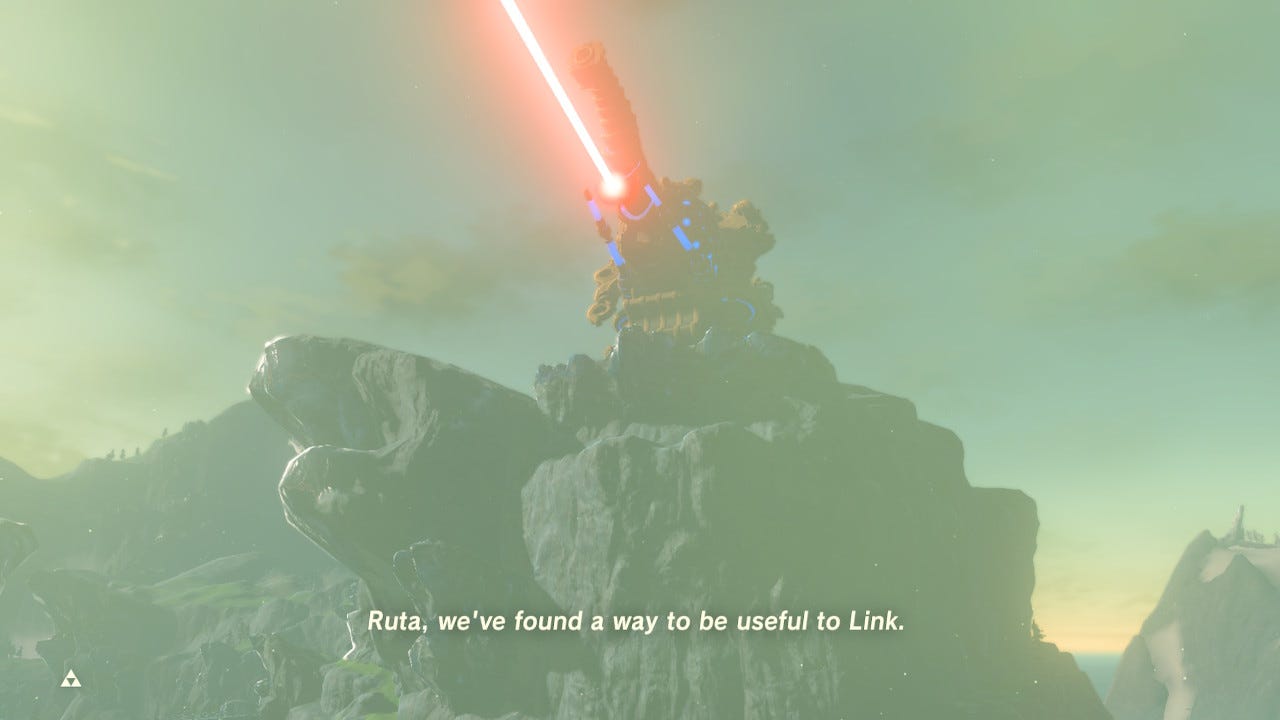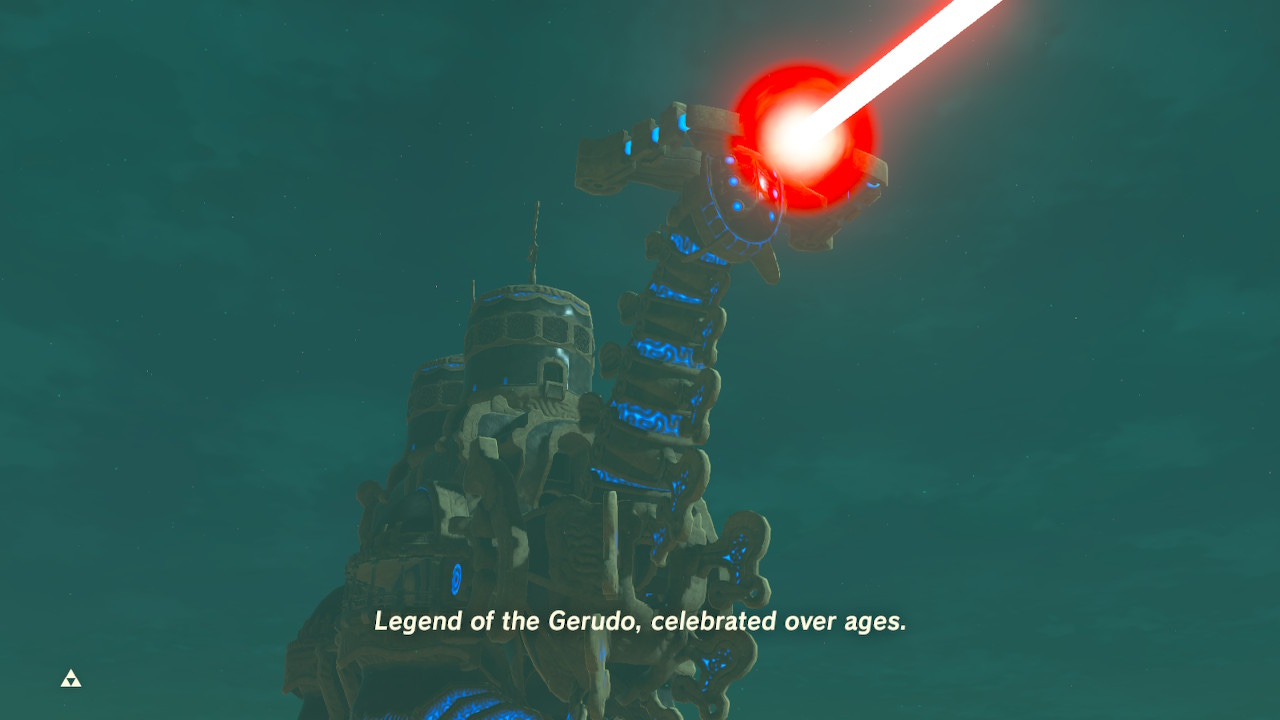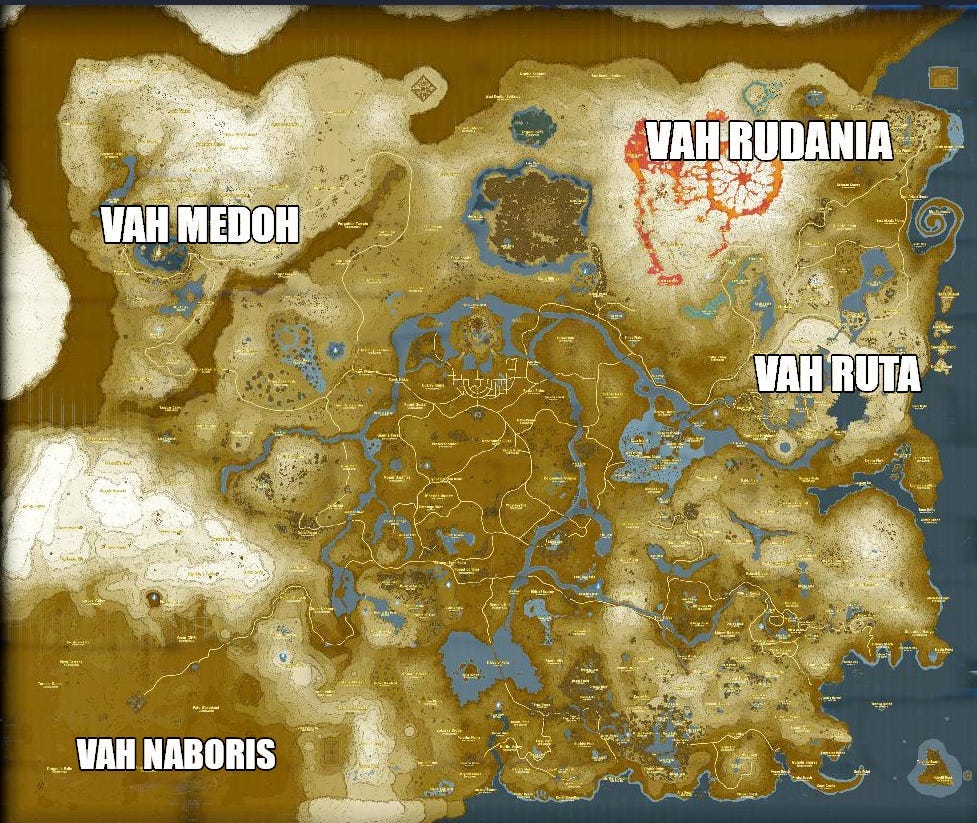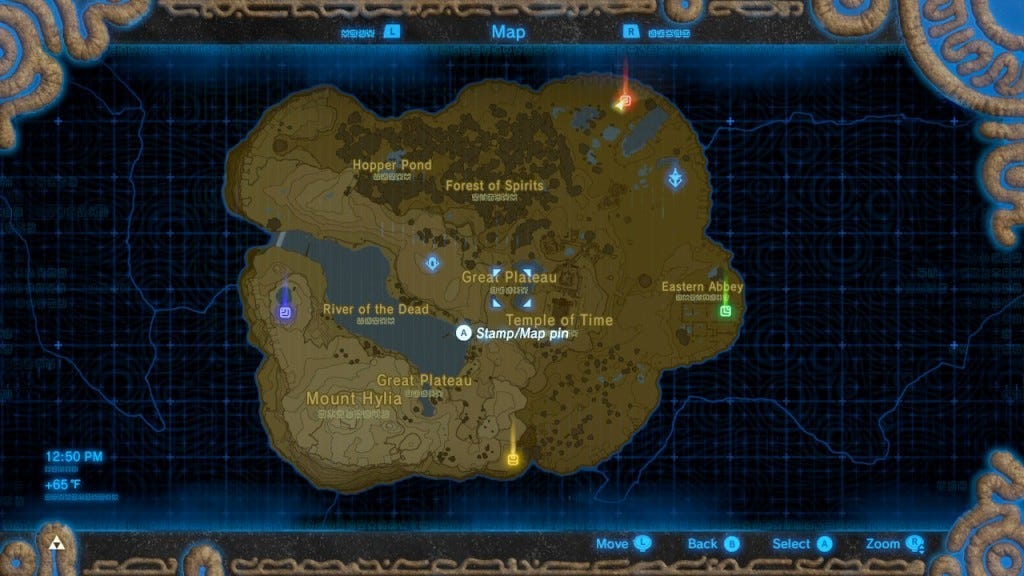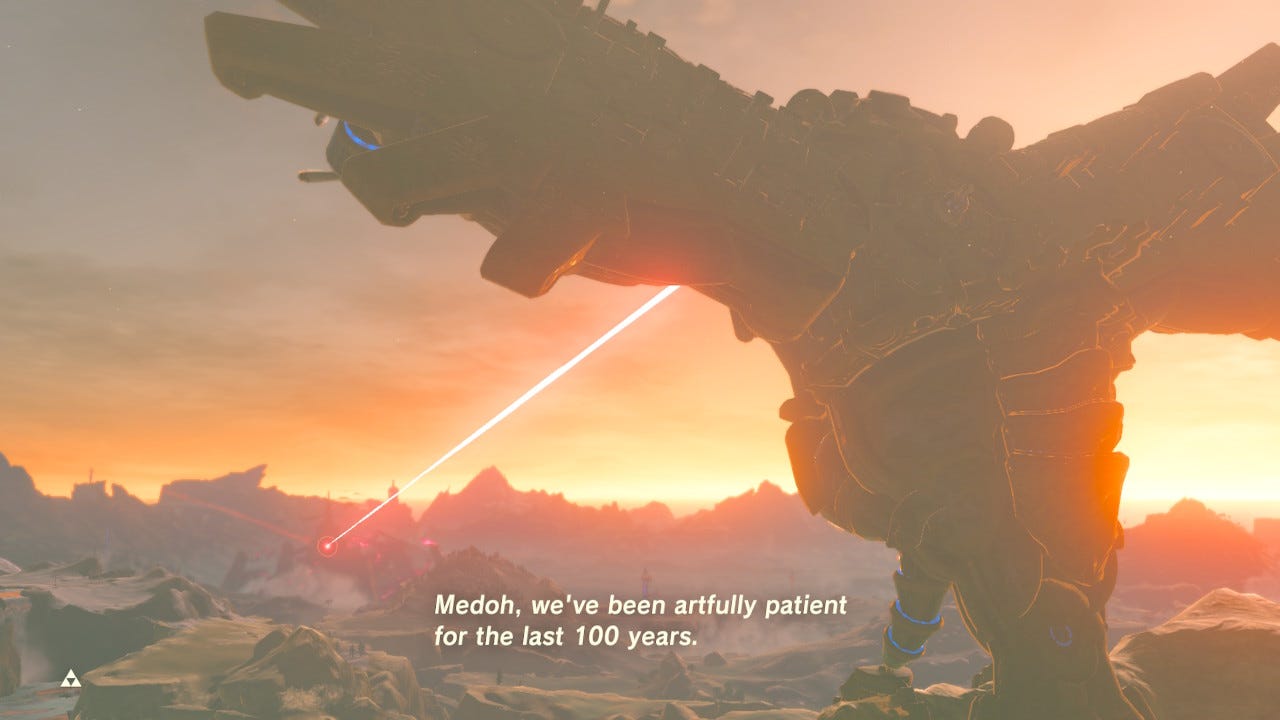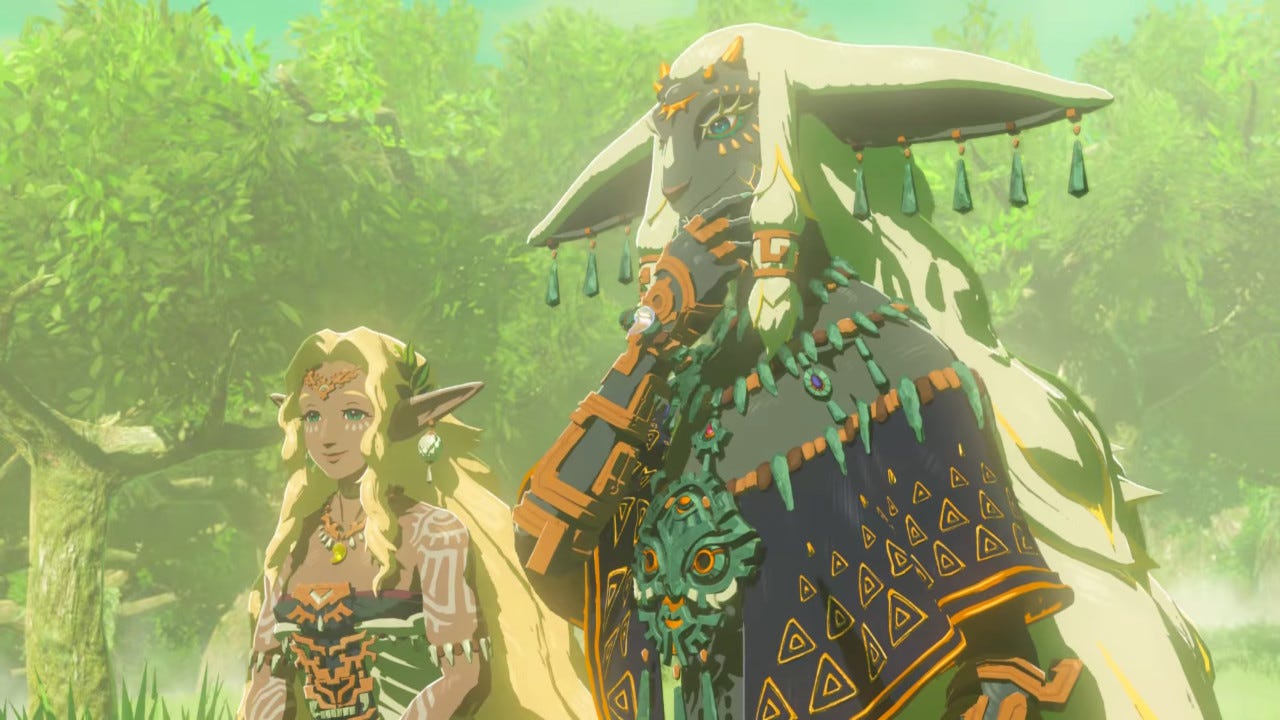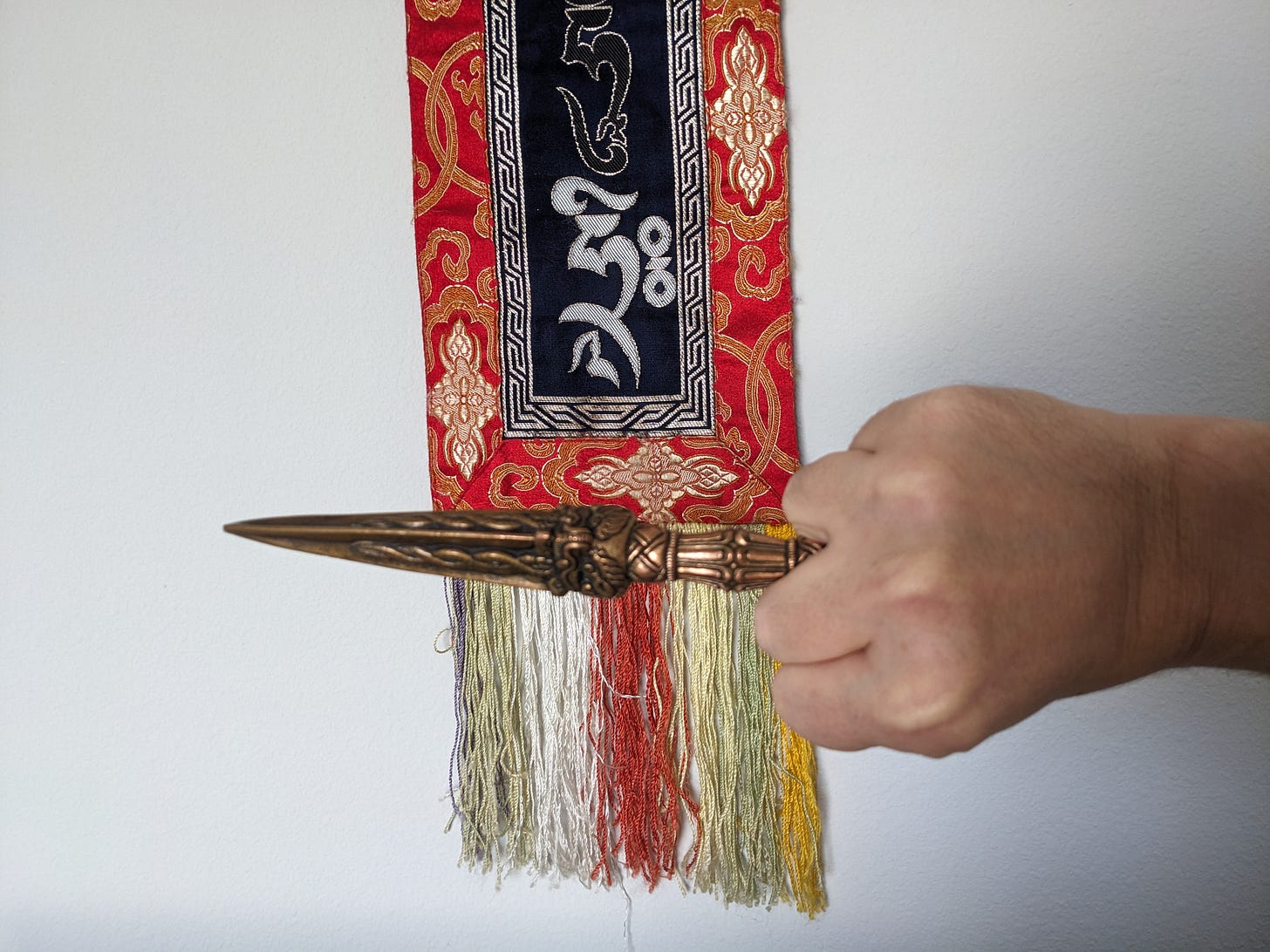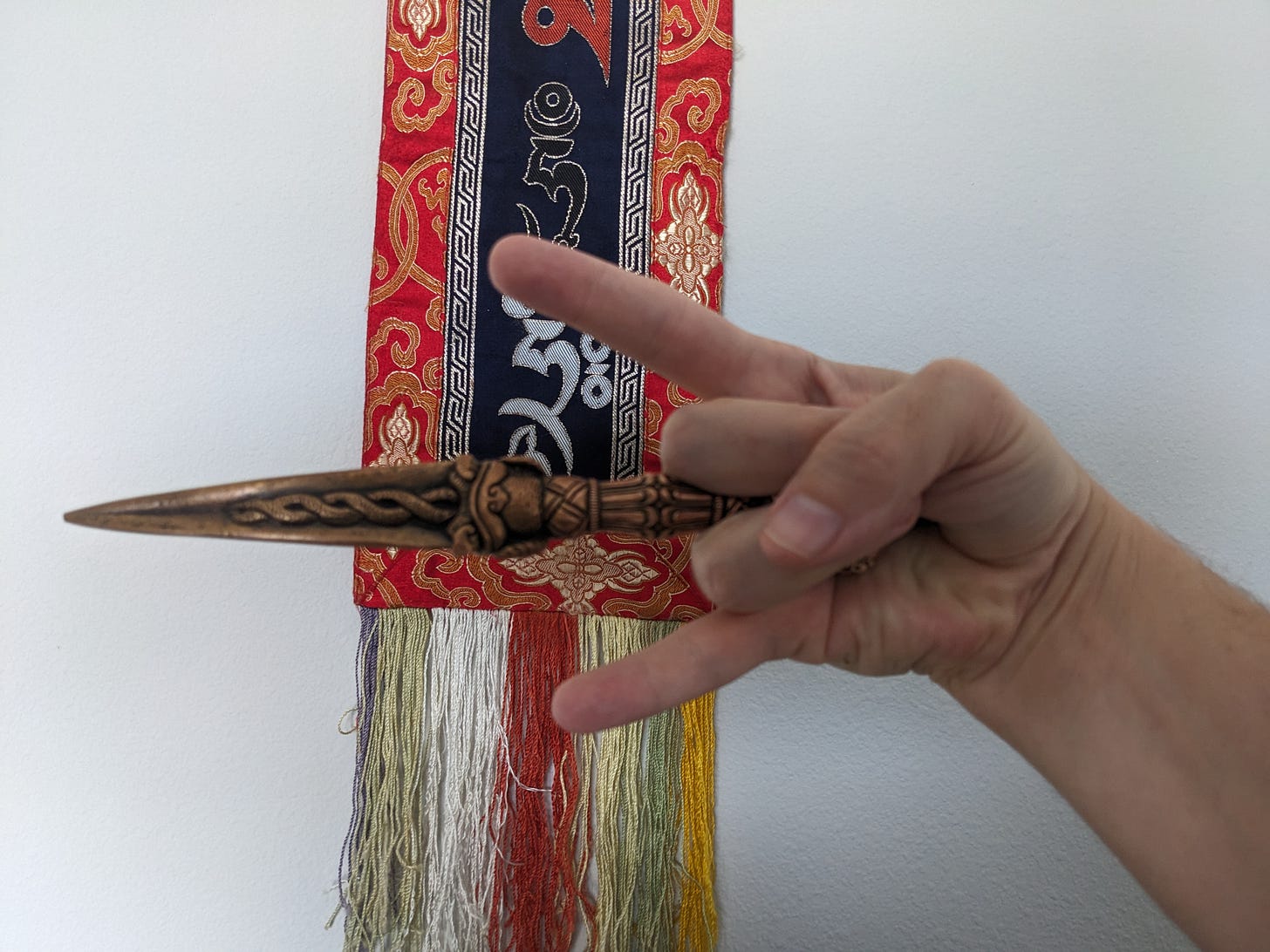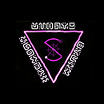Hello, my readers! It’s been a while since I’ve written a post and I am happy to be back at it. I’m also excited because this post will be my first truly practical contribution; thus far in Gogo’s World of Ruin, I’ve focused mainly on either sharing my personal experiences in the game The Legend of Zelda: Breath of the Wild or developing my theories inspired by the imagery and mythemes that appear in the game. In today’s post, I will be sharing the first of the more practical results of those experiences and ideas: A magic(k)al frame rite one can use to open ritual space.
Most of the basic correspondences forming the backbone of the ritual were lined up and introduced in the post The World Is Yours, and my readers may chuckle upon learning that my original intention was to immediately follow that post with one like today’s post. For various reasons it’s not really worth belaboring, it took me longer than I was hoping to distill everything into the detailed rubric I present here. Truth be told, the sharing and presentation of stuff like this was one of the very reasons I started writing Gogo’s World of Ruin; put simply, Nintendo—much like Disney—is very protective of its intellectual property, so I probably wouldn’t be able to get away with publishing a physical book with content like this. However, I can definitely share it online in a free post.
The ritual itself is really nothing all that flashy; I don’t claim to be some great magic(k)al innovator or anything (What? I don’t. I swear!!). This ritual is based on the personal banishing ritual I’ve been using for several years, which is in turn a fairly straightforward synthesis of The Lesser Banishing Ritual of the Pentagram (hereafter referred to as “LBRP”) from the Golden Dawn system and the Feri Sphere presented in the book Evolutionary Witchcraft by T. Thorn Coyle. Those familiar with the Golden Dawn system will recognize some conventions and symbolism drawn from the system. For those people, I would like to stress that I have no desire to construct a full, 1-to-1 Hylian conversion of the entire magic(k)al system such as, say, John Michael Greer’s Celtic Golden Dawn; as a practitioner of the Left Hand Path, I do not hold that there is anything about the Golden Dawn system’s symbolism that is truly necessary to the path of Initiation. Does it work for many people? Absolutely. Does it work for everyone? Hell no it doesn’t. Are its angels and planetary spirits even real? That’s debatable. For the purposes of Hylian magic(k), I’ll just say they’re “permitted.”
That being said, I have swiped a few tricks from the Golden Dawn playbook, but those familiar with that system should not necessarily expect their applications in this work to be fully analogous to their meaning and purposes in the Golden Dawn system itself. One of the very reasons I first synthesized the LBRP with the Feri Sphere is that while the sophistication of the Golden Dawn system is impressive and fascinating in its own ways, once more: It’s not the only way of doing things.
I find the relative accessibility of Feri witchcraft to be a very good thing. It’s easy for me to overthink all sorts of things, and the Feri ethos has served as a reminder to me that that isn’t necessarily a good thing—that there is much more to spiritual development and Initiation than developing the intellect. There are many ways of knowing and perceiving, including through one’s body and one’s emotions, and it’s not necessary for every tiny detail of the Initiatory path to be given explicit intellectual expression in the form of complicated systems of symbolism and correspondence in order to be valid. Some things simply ring true. We can know things in our bones, in our gut, and in our heart, not just in our head.
In case it doesn’t go without saying, one aspect of using the symbolism from a video game for magic(k)al work is that it’s fun, so this post should be read accordingly. That being said, as someone who has done serious Initiatory work and knows all too well how hard things can get, this ritual contains all of the most important details, and I have reason to believe that if practicing the LBRP can stir things up in one’s life and serve as a genuine Initiatory catalyst, there’s no good reason that this ritual cannot do the same.
Even if this were not theoretically true on its own (and, to be sure, it is), I performed a magic(k)al working on January 5th, 2023 to formally “consecrate” the game Breath of the Wild for such alchemical and initiatory purposes. Both the LBRP and the Feri Sphere involve visualizing the pentagrams in question lit up in blue fire; as it happens, the Blue Flame also has sacred meaning within the Zelda mythos. In eminently Promethean fashion, I built a ceremony around a quest in the game involving the carrying of the Blue Flame to light up the furnace at Hateno Ancient Tech Lab. While the flame in the game and the two rituals is blue, in my mind, the ritual served the purpose of seizing The Black Flame of Ipseity known on the Left Hand Path, and using it to spiritually “ignite” or “consecrate” the world of Hyrule in the name of The Princess of Darkness. You can read about that working in the post Set Flame to the Night.
Not that anyone who wants to work with this ritual truly needs it in order for the work to be valid, but know that when this ritual was performed, I was very much “inflamed” with divine fire and intentionally turned it to use in this domain. So It Is Done.
Like the rituals it is based on, this ritual can work at a basic level for just about anyone; also like the rituals it is based on, it will be much more effective and will simply resonate better for those who are already familiar with the source material, including Golden Dawn initiation, Feri witchcraft, and of course, The Legend of Zelda: Breath of the Wild.
As far as the latter goes, one of the things holding me back from developing a Hylian Banishing Ritual was the matter of the Zelda franchise’s complicated lore, which is based on a convoluted timeline with several branches. For the sake of holism, there was a recognition that it would probably be best for such a ritual to acknowledge the fullness of “the Zelda tradition” by somehow taking that entire timeline into account. However, last month, it would appear Nintendo decided to place Breath of the Wild and Tears of the Kingdom in their own separate timeline. As such, my task was rendered much simpler. As far as my personal experiences with the two games as genuine Initiatory vessels goes, learning of that decision made me feel good and added to the sense that the Kingdom of Hyrule as presented in the two games is, indeed, digital sacred space; the purpose of a magic(k)al frame rite is to establish just that: A closed, “hermetically sealed” magic(k)al and/or spiritual continuum that exists apart from the rest of the mundane world so that special work can be done. Nintendo itself has inadvertently done all the more to accomplish such an objective with regard to the world in these two games.
Perfection.
Overview
WARNING: SPOILERS for The Legend of Zelda: Breath of the Wild and Tears of the Kingdom beyond this point!
Like the LBRP, this “ritual” is actually two separate rituals. The LBRP is a self-contained ritual, of course, but in the Golden Dawn system, one almost always performs the Qabalistic Cross ritual before and after the LBRP proper. As for Feri, such an arrangement is roughly analogous to performing both the Feri Sphere and The Ha Prayer in the same session. Carrying this pattern forward, I’ve modified another ritual to go together with the Hylian Banishing Ritual (HBR) in a similar way: The KIA IAO Centering Ritual.
To be clear, I’m pretty sure the KIA IAO Centering Ritual is actually designed to function all on its own as an entire frame rite and does not necessarily need to be combined with anything else, so that original intent of the ritual is here modified along with its details and symbolism. My version is called The Triforce Rite (TR).
Similar to both The Ha Prayer and the Qabalistic Cross (QC), The Triforce Rite expresses and establishes the equivalence of the microcosm and the macrocosm. In other words, it ritually establishes the magician as an embodiment of the divine, in much the same way that the physical Triforce in Zelda lore is a manifestation of the transcendent Golden Power. From a Golden Dawn frame of reference, the Triforce in Zelda is essentially analogous to the Supernal Sephiroth at the top of the Tree of Life.
In establishing both vertical and horizontal axes anchored to the magician’s physical body, the QC is illustrating basic dimensions of physical space in an abstract sense, which serves to define the boundaries of the entire physical universe so that “LVX,” the Divine Light, can crystallize and take shape. This is a way of ritually stating the concept of “Light In Extension.”
In Feri, The Ha Prayer (referred to by Coyle as the “Prayer for Alignment” in Evolutionary Witchcraft) acknowledges, vitalizes, and aligns the Triple Soul, or the three parts of the self. It is based on the concept that our own breath is identical with the “breath of the divine,” which is expressing something similar to the above, though not quite the same thing. As Coyle put it:
In Feri Tradition, we believe that life force, magic, and our relationship to God Herself is available to us every time we draw breath. Life force is the inspirer, part of the divine breath. The Prayer for Alignment is based on our experience of breath as the great connector and enlivener. This prayer trains your breath, alters your body, and strengthens your spiritual presence. The breathing itself is the prayer, rather than the prayers of words we are more commonly used to. The Prayer for Alignment will help you in all things, especially when coupled with work on posture and your keys to remembrance.
Evolutionary Witchcraft
p. 71
For anyone who is already familiar with both the QC and the Ha Prayer and then learns of the KIA IAO Centering Ritual, it’s not too difficult to see how the latter ritual contains symbolic elements found in both the QC and the Ha Prayer. Whatever the authorial intent behind the KIA IAO ritual was, one can perform it with the other two rituals in mind and view it as a synthesis of all of the magic(k)al objectives covered by both.
The Triforce Rite essentially starts from there, but gives the KIA IAO ritual a “re-skin” in symbolism drawn from Zelda.
At any rate, the “full version” of the HBR starts with the Triforce Rite. If doing The HBR as a daily practice, one might as well do Triforce Rite > HBR > 2nd Triforce Rite, as is done with the QC and LBRP in the Golden Dawn. In applied ritual work, I think it’s best left up to the magician to decide whether or not the TR needs to be repeated after the HBR; I’m not going to be as strict and uptight about protocols here as the Golden Dawn tends to be.
Now to walk through the symbolism of the Triforce Rite.
Step #1 of the KIA IAO Centering ritual, wherein the magician points up with one finger and down with other, vibrating “KIIIIIAAAAAAAA,” is eschewed here and instead we go directly to step #2.
Instead of the I-A-O of the KIA IAO Centering Ritual, the syllables here are "Hy-li-a.” Hylia is the Great Goddess of Zelda lore, and in this regard, the Hylian Banishing Ritual aligns more with the Feri Sphere than with the LBRP in that here, the divine is viewed as being feminine in nature as opposed to masculine.
In step #2 of the KIA IAO ritual, the magician raises their arms above their head and visualizes a vertical axis of light passing through the heart, chanting “Ieeeeeeeeeeeeee” in a high pitch; in the Triforce Rite, this is largely unchanged, though the syllable is “Hiiiiiiiiiiiiiiiiii” (rhyming with “eye”). In addition, the magician visualizes the ice dragon Naydra circling overhead. Naydra is the dragon of Wisdom, corresponding with that same aspect of the Triforce. This all lines up well because in-game, Naydra is associated with the peak of Mount Lanayru, which reaches up into the heavens. Nonetheless, the axis of light visualized by the magician connects the heavens, the earth, and the underworld together.
In step #2 of the Triforce Rite (corresponding with step #3 of the KIA IAO ritual), the magician lowers their arms, extending them out to both sides in the form of a Tau cross and vibrates “Liiiiiiiiiiiiiiiii” (as in the name “Lee”) in a medium pitch while visualizing a horizontal axis of light extending in both directions. The magician visualizes the thunder dragon Farosh circling about their midsection. In terms of the Triforce, Farosh is the dragon of Courage, and whereas step #1 corresponds with the Goddess Hylia, step #2 corresponds with The Hero of the Wild (that would be Link), or the magician oneself.
In step #3 of the Triforce Rite, the magician brings their hands down to meet just below the belly button, forming an O with their arms, and vibrates “Aaaaaaaaaaa” (as in “ah”) in a low pitch. The magician visualizes the fire dragon Dinraal circling beneath their feet, analogous to the fiery core at the center of the earth. Dinraal is the dragon of the Triforce aspect of Power. This step corresponds with The Horned God, the counterpart to the Goddess Hylia, who rules the underworld.
The magician then finishes off the Triforce Rite by bringing the palms of the hands together at the level of the heart (similar to the Thai “wai” gesture) and visualizes The Light Dragon coursing around them, not unlike the ouroboros visualization in the KIA IAO ritual. This works out really well because the official logo for The Legend of Zelda: Tears of the Kingdom prominently features a “dragon-like” ouroboros motif.
The LBRP proper and the Feri Sphere are both so similar in structure, it’s not even funny. Each is based on the four cardinal directions of the compass; in each, the magician begins facing in a specific direction: The East in the case of the LBRP, and the North in the case of the Feri Sphere. This mirrors in interesting ways a detail I noted about the spire of the Temple of Time at the end of the post What Child Is This: A Merry Zelda Yule. At the very end of Breath of the Wild’s starting area, The Great Plateau, Link is given the paraglider by The Old Man (an Odinic Initiator/psychopomp figure) in the steeple of the Temple of Time, which also has holes knocked out on its north and east sides. The paraglider allows Link to leave The Great Plateau safely, beginning his quest in earnest, and these eastern and northern openings symbolically give Link the choice to begin his quest in either direction. This is a definite threshold or liminal space, and it occurs after Link has completed a small “trial” involving the collection of four Spirit Orbs from shrines spread out evenly at the rough periphery of The Great Plateau.
Is this opening to the game, in a sense, its own little “frame rite?” I do believe so! In fact, I have gone so far as to include the four “Runes” Link receives from this quest—one in each Sheikah Shrine—in the directional and elemental correspondences of the HBR.
I digress, SHIT! Anyway. The magician begins facing either North or East and draws a pentagram with their dagger, visualizing it in blue flame, recites or “vibrates” some incantation, acknowledges or visualizes some divine entity, and activates in some way an elemental force associated with said direction and divine entity. Then, the magician makes a quarter-turn in one direction or the other, doing the same with the next direction/entity/element in question, drawing a connecting line from one to the next, eventually coming all the way to the first direction. At this point the “connecting lines” between the directions wind up forming a circle which essentially defines the sacred space established by the ritual.
One of the things I like about the Feri Sphere—and probably the main reason I syncretize the LBRP and the Feri Sphere in the first place—is that it also explicitly addresses the directions of “above” and “below,” forming a complete sphere. Although it’s arguable that the LBRP does something similar with the visualization of the hexagram above and below the magician after addressing the four quarters, it’s just not really the same concept.
The HBR does virtually all of the same things, but again, there are some nuanced differences just as there are between the LBRP and Feri Sphere respectively.
In the Golden Dawn, the beings assigned to the cardinal directions are the four archangels from Christianity; in the Feri tradition, each direction and element corresponds instead with a Guardian. The archangels, while visualized clearly as angelic humanoid beings with wings, are nonetheless fairly abstract in nature and aren’t conceived of so much as “beings,” but rather something more like cosmic “forces,” albeit conscious ones. In contrast, the Guardians in Feri are much more distinct and individualized as entities in their own right, akin to deities, with whom the Feri witch can form a personal tutelary relationship.
In the HBR, the beings assigned to the cardinal directions are the four Divine Beasts, and once more, the dynamic here splits the difference between the Golden Dawn and Feri models. The Divine Beasts themselves are more like the Golden Dawn’s archangels; being essentially “mobile temples” as well as mechanical “vehicles,” they are less personal and more distant. However, each one is also piloted by a Champion, each of whom is a person, suggesting the potential for interaction and relationship.
Assigning the Divine Beasts to cardinal directions was a bit of a tricky prospect that required some reflection, especially because the four elements in Breath of the Wild are different from the traditional ones used in both the Golden Dawn system and the Feri tradition—so basing the attributions on the elements was obviously a non-starter.
Another option that may come to mind is for the magician to assign the attributions themself, based on whatever fits best with their geographic location; that is, if you’ve got a coast off to the south, then perhaps Water should be assigned to that direction, and so on. Of course, I invite the reader interested in putting this ritual to use to follow their own inspiration, but I have not done things this way, and that is for a specific reason related to this whole paradigm.
In the LBRP and the Feri Sphere, the cardinal directions are tied to the physical universe—the real, actual physical universe in which the magician acts. This is especially true with the Feri Sphere. However, the lands to which the HBR are (symbolically) tied are those of Hyrule itself. As such, I based the attributions on the geographic locations of the Divine Beasts in-game. A glance at their locations reveals the snag: The Divine Beasts are most certainly not clearly tied to the cardinal directions in the map layout. In fact, they’re much closer to being assigned to the cross-quarters, though even then the situation is kind of lopsided, with Vah Rudania and Vah Ruta being somewhat “squished” closer together:
Nonetheless, one can look at this layout and see that while none of the positions of the Divine Beasts neatly align with a cardinal direction, there is nonetheless a “northernmost” Divine Beast, an “easternmost” one, etc. With Vah Naboris and Vah Medoh, it’s pretty close (made all the more tricky by the fact that each of these two Divine Beasts also wanders on its own basically circular path), but if one were to draw a line north from Vah Naboris’ position, Vah Medoh is just a smidge farther to the West than Vah Naboris is, which seals the proverbial deal.
As for the locations of the Sheikah Shrines on the Great Plateau, the associations with the cardinal directions are much clearer:
I will now explain the correspondences as I see them. Aside from the cardinal directions and the four Runes, the main attributions used in this ritual are summed up in the post The World Is Yours.
East
The East corresponds with the elephantine Divine Beast Vah Ruta and everything else associated with that Beast, including the element of Water, the Zora people, and Princess Mipha (Ruta’s Champion) with her power of resurrection, Mipha’s Grace. The Rune of the East is Bomb, which happens to line up well; in the post The Four Gifts of the Great Plateau, I point out that the Bomb Rune is Jupiterian in nature, in that Jupiter’s energy is expansive and sometimes volatile, which is mirrored by the explosive activity of bombs. Meanwhile, the Jupiterian symbolism surrounding Vah Ruta is…extensive.
“Ruta” is a single letter away from “ROTA,” the word appearing on the face of the Wheel of Fortune in the Major Arcana of the tarot—which is ruled by Jupiter. The city of Zora’s Domain is also wheel-shaped. When Link visits, he receives a quest to ascend the peak of the nearby Mount Ploymus (which the reader will note is an anagram of “Olympus”) to collect lightning arrows (thunderbolts, as wielded by Zeus/Jupiter) that have been fired by the Lynel (kind of a centaur-like being with lion-like features, or in other words, a chimeric being not unlike the sphinx which traditionally sits atop the Wheel of Fortune) who roams the peak. You get the idea. That entire region of the game is an embodiment of Jupiter and its corresponding tarot trump.
The action associated with the East is “rising,” which I will explain in due course.
South
The South corresponds with Divine Beast Vah Naboris, the camel—and thus with the element of Thunder, the Gerudo people, the Champion Lady Urbosa and her power of Urbosa’s Fury. The Rune assigned to the South is Stasis, which allows Link to temporarily stop time for a specific object (or, once upgraded by Purah at Hateno Ancient Tech Lab, even an enemy monster); during the temporal freeze, Link can then strike the object repeatedly, thus charging it with kinetic energy. When the freezing effect ends, all kinetic energy built up into the object is set loose and applied, and the object will be launched on a trajectory determined by the amount of kinetic energy built up and the direction of the final strike.
Honestly, I don’t see this Rune correspondence aligning as much with its direction and other attributions as Bomb does with East, but that is okay. This is actually part of the fun of establishing these correspondences: It’s a work in progress and not every aspect of the system was intentionally determined by me. Some of it is happenstance, and thus there is an element of mystery here which leaves room for growth. I have thus far enjoyed making a practice out of this ritual framework and letting the resulting associations, understandings, and meanings develop over the long term via meditation and reflection.
The action associated with the South is “falling.”
West
The West corresponds with Divine Beast Vah Medoh, the eagle, along with the element of Wind, the Rito people, their Champion, Revali, and his power of Revali’s Gale, which empowers Link to generate a cyclonic updraft of wind to carry him pretty far up into the air. The corresponding Rune power is Cryonis, which allows Link to form up to three separate large blocks of ice from water found in the environment surrounding him. These ice blocks have all sorts of uses, including forming a platform from which to reach high places, or as a means of crossing water aside from swimming (which eats up Link’s Stamina and comes with the possibility of his drowning if the Stamina runs out before he can reach solid ground again), or serving as a shield to block incoming attacks or projectiles.
Again, the relationship between a Rune like Cryonis and an element like Wind is not intuitive or immediately apparent. However, I see some interesting alignment in the way Cryonis (which forms a solid) contrasts with its “opposite” Rune, Bomb (which generates an expansive force corresponding loosely with the gaseous state of matter). Again, time and reflection will likely yield interesting insights, but if not, oh well. Remember: Fun. This ritual and its attendant system are additional tools for a magician and not meant to be their end-all, be-all.
The action associated with the West is “falling,” which, I realize, does clash a bit with the purpose of the Champion’s Ability of Revali’s Gale. So it goes.
North
The Divine Beast of the North is Vah Rudania, the salamander of Fire who climbs about the volcanically active Death Mountain. This means North is also the direction of the Goron people and their Champion, Daruk.
The elemental attribution for North takes some explaining. In-game, Vah Rudania’s element is named “Fire,” which is well and good. However, when it comes to elemental balance for the purposes of real-life magic(k), this doesn’t immediately seem to work very well because, without any further modification or elaboration, there are no elements in this system that express the principle of material solidity associated with the magic(k)al element of Earth.
As far as the other elements go, Wind is Air and, of course, Water is Water; meanwhile, “Thunder” is more accurately focused on lightning, which has a whole lot in common with the real-life element of Fire. In this sense, if I were to align these Hylian elements with the ones used in real-world Western magic(k), I’d connect Hylian “Thunder” with the real-world element of Fire…and this would leave the Hylian element of Fire to line up with the real-world element of Earth.
This actually makes a lot of sense as seen from two different perspectives:
Although the element of Vah Rudania is technically Fire, there’s a lot about its associated region and lore that speak much more to the real-world element of Earth than that of Fire. For one, the Goron people are big, burly dudes (all of them are male) who eat rocks and spend their lives mining for ore (both “earthy” behaviors). In fact, Gorons reproduce asexually and are instead literally born from the earth itself. Lastly, Daruk’s Champion’s ability, “Daruk’s Protection,” forms an impenetrable shield that protects Link from all damage one time. In contrast with Urbosa’s lightning-based attack, that’s about as “earthy” as it gets. So while the element here may be called “Fire,” in a magic(k)al sense, we are thinking of “Earth” in the North instead.
Now we’re going to get downright ontological. Hee hee! If you think about it, from an in-game perspective, given the choice between “Fire” and “Thunder,” which one corresponds more closely with the real-world element of Earth to you? In the grand scheme of things, the magic(k)al element of Earth also corresponds with all physical matter. If you are a character in a video game, what is your world made out of? Well, yours is a digital world, existing as data on some physical storage medium as far as the “real world” is concerned, but none of that data takes the form of 3-dimensional objects and structures until the Nintendo Switch is turned on and the program is run…so in a way, the “material” world of Hylians is made of electricity…or Thunder. So oddly enough, to a Hylian, Thunder is the “Earth” element, even though to we human beings, there is much more in the symbolism related to the North and “Fire” that seems “earthy” to us. In other words, it’s all relative.
So, it takes some serious mental gymnastics, but North is where we flesh-dwelling human beings find our “Earth” element, even though it is called “Fire” in-game.
I really hope that makes sense.
Anyhow, the Rune ability of the North is Magnesis, which allows Link to use magnetic force to lift and move metallic objects no matter how heavy they may be. This, too, supports our understanding of Hylian “Fire” as being related to the magic(k)al element of Earth, because our planet’s electromagnetic field is generated deep in the earth—specifically, by the molten layer of the planet’s iron core, which aligns well with the North and Hylian “Fire” since the Gorons live at the foot of a volcano which is active due to Vah Rudania’s lashing out during the time of Breath of the Wild. It also aligns well with its opposite element, because then you’ve got electricity (“Thunder”) in the South and Magnetism (Magnesis) in the North—in other words, the North-South axis comprises the principle of electromagnetism.
So it’s a bit cumbersome, but this all ends up working out pretty well. Thank you for bearing with me here.
Lastly, the action corresponding with the North is “rising.”
Powers Above
As I mentioned earlier, one difference between the Feri Sphere and the LBRP is that the Feri Sphere specifically honors the Powers Above and the Powers Below, forging a complete sphere where the LBRP basically forms a flat disc with a column of light running through its center. I like the sphere concept more, so I went ahead and incorporated these aspects of the Feri Sphere into this ritual.
The coolest part is how this ends up reflecting the land of Hyrule in unexpected ways. As I said, this ritual is based on my own personal banishing ritual, which I was using during Breath of the Wild’s release and before its sequel, Tears of the Kingdom, came out. So I was already running around in Hyrule and coming up with the earlier versions of this ritual, and then Tears of the Kingdom was released, which is cool because one of the major features of that game is that not only does Link have stuff to do in the land of Hyrule proper, but there are also entire game maps both up in the sky and underground. As such, ToTK has an upper world (The Sky Islands), a middle world (Hyrule itself), and a lower world (The Depths).
The Powers Above correspond with the Sky Islands. There is even a people that can be said to correspond here even if they are technically extinct during all of Link’s adventures in Hyrule: The Zonai, the ones who built the Sky Islands. In-ritual, the element for Powers Above is Light, since the sun shines most abundantly and consistently in the Sky Islands. We can also say that instead of a Divine Beast for the Powers Above/element of Light, there is The Light Dragon, and instead of a Champion, there is the pair of King Rauru and Queen Sonia, who together founded the Kingdom of Hyrule over 10,000 years prior to the events of Breath of the Wild. For another spin, we can just as well name Princess Zelda as the “Champion” of The Powers Above. We can also carry over the attribution of The Goddess Hylia from the Triforce Rite.
“Powers Above” in this context also corresponds with the Self in the Jungian sense of the term.
Powers Below
Obviously, then, Powers Below corresponds with The Depths, a dark underworld to which the dead travel, one with a terrain which is an inverted/mirror image of the geography of Hyrule’s surface; where Hyrule has a mountain, The Depths have an oddly cone-shaped, steep canyon, and so on.
The element of The Powers Below is, of course, Darkness. In a Jungian sense, The Depths represent the unconscious mind as a whole, as well as the Shadow in particular.
The “Champion” attributed to The Powers Below is none other than Ganondorf himself—the arch-villain of this Zelda timeline (and, for the most part, throughout the main Zelda timeline). The “Divine Beast.” in contrast with The Light Dragon, is The Demon Dragon, who—as those who have beaten Tears of the Kingdom know—is simply the “immortal” form of Ganondorf, after he ingests his Secret Stone.
Accordingly, the “people” corresponding with The Powers Below are the monsters comprising Ganondorf’s forces, which Link encounters all throughout both games.
An attribution can also be made with The Horned God as ported from The Triforce Rite.
Center
Lastly, the Feri Sphere honors the “direction” of the Center, the locus of the heart. This brief but meaningful pause is important. If there is a “people” associated with the heart center, let it be the Hylian people as a whole, with Link their Champion.
I like the way all of this symbolism shakes out, because by placing the game’s villain where we do, in line with the central vertical axis and associated with The Depths, what we’re saying is that “evil” is a potential that exists within all of us, generally residing in the Shadow even for people who ought to know full well how “evil” they are. In other words, the greatest evils committed by human beings are products of unconsciousness or ignorance, of a lack of awareness/enlightenment.
The Demon we perceive without is simply our own Shadow, which lives inside of us; not a single living person is fully beyond the reach of this archetypal figure. After all, the real monsters of this world are human beings.
Ganon is a reflection of Link, and of Princess Zelda. This is why each one stands for a different aspect of the one Triforce.
“The Powers Above” and “The Powers Below” are also where the action attributions of “rising” and “falling” from the cardinal directions come into play. As I am currently practicing the ritual, I begin facing the East and circle the elements deosil. I want to leave room for some flexibility (and there is likely some deeper symbolic meaning to be developed as I experiment with different ritual arrangements over time), so I’ll anticipate the possibility of forming the circle in either deosil (sunwise/to the right) or widdershins (anti-sunwise/to the left) directions for the horizontal circle that parallels the horizon and aligns with the cardinal directions. As I already suggested from the symbolism of the Temple of Time’s broken steeple, one can just as well begin facing North as East; really, I suppose one can start anywhere, but for now I am sticking with the constraints of symbolism I’ve already identified both in-game and in the real-life rituals this one is based upon.
At any rate, the observant will notice the complimentary nature of the “rising” and “falling” actions attributed to the various directions; that is, where we see rising as the action attributed to a given direction, its opposite direction will align with “falling.” This forms the flow of the circle that runs parallel to the vertical axis, perpendicular to the horizontal circle—whether this circle aligns with the East-West axis or the North-South axis, which will be determined by the direction in which the magician begins the ritual. You’ll see what I mean in the Instructions section.
Note that the intersecting circles drawn in this ritual—each one rotating along its own axis—are symbolic of the “two revolutions of the wheel” from the engraving of Ezekiel’s vision that is referenced in the post The World Is Yours. Mystery solved!
The Triangles
The next thing to cover is what to draw in each of the cardinal directions, as well as above and below. In the LBRP, the magician draws upright pentagrams and visualizes them as bright blue and flaming. In the Feri Sphere, the witch draws upright pentacles (the same as the LBRP’s pentagrams, but also enclosed in a circle).
In the Golden Dawn, there are a whole bunch of different elemental versions of the pentagram, as well as both banishing and invoking versions of each, all depending on which point one starts with and the direction in which one moves from that starting point. By contrast, in the Feri Sphere, there’s pretty much just the one version of the pentacle, though there are both banishing and invoking methods for drawing it.
In the Hylian Banishing Ritual, I’m currently working in a middle-ground somewhere between the two levels of complexity.
This is one of the areas where I see the most room for experimentation and creativity and this aspect of the ritual is very much still in an early stage of development, but I’ll share the technique and meanings I’m presently working with. I encourage others to experiment with this, and by all means, please share your ideas and/or experiences here in the comments if you feel moved to do so.
Instead of working with pentagrams, I’ve been working with triangles, representative of the Triforce. Instead of an upright triangle—only because I’m a proud member of the Left Hand Path—I use an inverted triangle. The reader should note that this does not connote “evil,” nor does it suggest the “subjugation of spirit by matter,” as is often the professed meaning of an inverted pentagram. Instead, I follow a symbolic convention popular in many Left Hand Path circles wherein the upright triangle—resting firmly on its base—represents stability/stasis, whereas the inverted triangle—balancing on a single point—suggests constant movement, activity, and dynamism, almost like a spinning top viewed from the side.
I draw the triangle differently depending on whether I want to emphasize invocation or banishing, similar to the Golden Dawn pentagrams. For an inverted invoking triangle, I begin with the top-left point and trace the triangle down to the bottom point, up to the top-right point, and back across to the top-left. For an inverted banishing triangle, I start at the bottom point and trace the triangle up to the top-left point, across to the top-right point, then back down to the bottom point.
I don’t use a blue flame myself, but I would suggest for those who want to keep the ritual as basic as possible—as well as closely aligning with Zelda symbolism—to follow the precedent set in the LBRP and Feri Sphere and visualize the triangle in blue flame.
I myself work instead with The Red Flame and The Black Flame. In my conception of things, the Red Flame represents power, whereas the Black Flame represents sovereignty/ipseity. In other words, the Red Flame is best for sorcerous workings aimed at manifesting specific, concrete results, or what some people refer to as “low magic(k),” whereas the Black Flame is used for workings of an Initiatory nature that aim to reinforce and consolidate one’s individuality—in essence, “high magic(k),” albeit from a Left Hand Path perspective.
I use two different forms of the recitation at the end of the ritual depending on which flame I’ve used. This will be covered in the Instructions section.
Again, there is nowhere near as much variation or depth here as there could potentially be given the various working parts at play and the source material from which this ritual is drawn. Again, I invite anyone who is interested to play around with this. One idea I have which comes off the top of my head is to develop a symbol scheme using flames in the colors of the three aspects of the Triforce (Wisdom=blue, Power=red, Courage=green) just to be as consistent as possible about keeping the symbolism lore-related. If I end up developing such a system, I will of course share it here at Gogo’s World of Ruin!
Charging the Triangles
In the LBRP, after each pentagram is drawn, it is subsequently charged using a gesture called The Sign of the Enterer, which is a whole-ass technique in and of itself that takes practice to master to the degree that it can be performed in-ritual without undue effort or overthinking.
In the Feri Sphere, the pentacles are simply drawn with the dagger, and then a phrase expressing the elemental nature of the direction in question is spoken.
For the HBR, I use a technique that combines gestures with the approach (and almost the same verbiage) as the Feri Sphere; however, the gesture is a unique one I created, involving alternating between three separate “grips,” or ways of holding the dagger. I’m now able to make this switch pretty fluidly with one hand, and I must say that this is greatly aided by the shape of the ritual tool that I use in place of a traditional athame: A phurba. I am honestly not sure how well this would work with a more standard dagger. I would say, given the efficacy of Feri witchcraft despite the absence of a specialized “charging gesture,” that the Sign of the Hero (as I have dubbed this charging gesture) is not required, and if you find it cumbersome, simply don’t use it. You can just draw the triangles and say the lines and that would work just fine.
That being said, I’ll teach you The Sign of the Hero.
The dagger is held in the right hand.
The magician begins by holding the dagger straight out in front of oneself in a “normal” grip which I call the “drawing grip.” Simply hold the dagger out, thrust it into the point where you are beginning your triangle, and draw the triangle.
Next, the magician raises the dagger’s point up to the center of the triangle while transitioning to the “firing grip,” which involves holding the dagger such that the pommel is pressed into the magician’s palm, with the handle protruding out from in between the middle and ring fingers (if you’re using a standard athame and it has a crossguard, without a very prominent pommel, you might have to adapt the grip to wrap the fingers around the crossguard and have the blade protruding between the fingers instead of the handle; but seriously, try to avoid that because it doesn’t seem very safe); the palm and four main fingers are wrapped snugly around the pommel and the magician does whatever feels best with the thumb. The idea here is that the dagger is now an arrow, which will presently be drawn and “fired” in order to charge the triangle.
The left hand is raised and held out forward, in an upright fist, as if the magician is holding a bow with it. The right hand, with the dagger held in the firing grip, is held up next to the left hand, as if the magician were “nocking” the dagger (as an arrow) to the bow string. The magician assumes a solid archery stance, holds the left/”bow” hand in place, and draws back the right/”arrow” hand with the dagger as if pulling back on the bow string. The dagger is pulled all the way back so that the right hand, still in firing grip, is next to the cheek, around the ear, pointing forward. The idea is to mimic the position from which an archer aims the arrow before firing.
The magician inhales, drawing in energy, filling the lungs. The next part involves two simultaneous motions with the hands/arms, each running in complimentary directions, along with a powerful, forceful exhalation.
With the right hand, the dagger/”arrow” is forcefully thrust forward so as to pierce the triangle, quite similar to the way the pentagram is “pierced” in the LBRP. While performing this motion, the hand is also rotated so that the back of the hand and top of the forearm face up. At the same time, the magician extends the pinky and index fingers, keeping the middle and ring fingers wrapped around the pommel, and tucking the thumb underneath, in a grip resembling a common banishing gesture. The net effect is that, taken together, the dagger’s blade and the extended index and pinky fingers form a trident. This is the “striking grip.”
At the same time, the left hand is drawn back; it may feel counter-intuitive, but just assume the bow sort of disappears at this point. The left elbow is pulled back behind the magician, the arm is rotated so that the bottom side of the arm is facing up, and the hand is put into pretty much the same form as the striking grip, but without the dagger; the upturned forearm is also held straight from the drawn-back elbow, so that the left/back arm—along with the pinky and index fingers—are aiming in essentially the same direction as the right arm/dagger/”arrow.”
At the same time, the magician leans forward, in a manner similar to how they fall upon their foot in the Sign of the Enterer, with the right foot in front.
At the same time, the breath is exhaled somewhat forcefully, and through pursed lips, the breath “blown” through the triangle. We want to “charge” it with our breath and we want it to feel effortful so that there is a sense of great, applied “energy.”
The resulting stance involves slightly bent knees, the left foot behind the magician to hold them stable, the right foot forward so as to put the magician in a slight “crouch,” with the right arm held completely straight and fully-extended forward and the back arm bent at the elbow, pulled back, with the forearm pointed forward, fingers wrapped in the striking grip. There’s kind of a “karate” vibe to this stance.
I am sorry if this sounds overly complicated; it took me some practice to get down and I’m the one who invented the gesture! As I said, this is all gravy and you don’t necessarily have to do it this way; however, there’s a bunch of symbolism at play here and that’s why I developed the sign. One of Link’s important weapons is the bow and arrow; in rather “Apollonian” symbolism, the cleansing of each of the Divine Beasts of Calamity Ganon’s corruption always involves the firing of arrows at key vulnerable points on the bodies of the Divine Beasts themselves.
At that, it’s now time to run through the entire ritual script from beginning to end.
Instructions
The Triforce Rite
Raise both hands above your head, visualize a vertical axis of light passing through your heart, connecting you to the Sky Islands and The Depths. Naydra, the ice dragon of Wisdom, circles slowly overhead. Chant/vibrate the syllable “Hiiiiiiiiiiiiiiiii” (rhymes with “eye”) in a high pitch.
Lower your hands until they are stretched outwards to your right and left, your body forming a Tau cross. Visualize a horizontal axis of light stretching left and right from your heart, forming a cross with the vertical axis. Farosh, the thunder dragon of Courage, slowly circles you at the level of your torso. Chant/vibrate the syllable “Liiiiiiiiiiiiiiiiii” (as in the name “Lee”) at a medium pitch.
Lower your hands again, curling your arms until they form a letter O, your hands overlapping a little below your belly button. Dinraal, the fire dragon of Power, circles slowly in The Depths beneath your feet. Chant/vibrate the syllable “Aaaaaaaaaaaaaaaaaa” (as in “ah”) in a low pitch.
Bring your palms together, with fingers straight, almost in a “prayer” gesture around the level of your heart. Inhale deeply, close your eyes, and exhale slowly as you visualize the Light Dragon, in circular form like an Ouroboros, slowly circling your entire body. Its path begins above your head, descends down your right side, circles down beneath your feet, then rises up your left side. Its path is wide enough to completely encircle not only you, but the paths of the other three dragons.
The Hylian Banishing Ritual
Face the East*.
Begin with your dagger in your right hand, held down at your side in the drawing grip. Stand upright and hold your head up proudly. Close your eyes and take three slow, deep, deliberate breaths.
Raise the dagger before you and draw the desired triangle (banishing or invoking, upright or inverted), tracing a triangle that lights up in the color of the desired flame. As you do so, say, “By the living waters of Her teeming womb, and to the East beyond the East.”
Charge the triangle with The Sign of the Hero (Optional), or simply pierce it after drawing it. Chant/vibrate “Vah Ruta.” Visualize Divine Beast Vah Ruta rising from the waters off of Hyrule’s east coast in a triumphant spray, with the Dueling Peaks in the foreground, piloted by the Zora Champion Princess Mipha, who proudly wields the Lightscale Trident.
Return to holding the dagger in the drawing grip (if applicable) and turn 90° to the right so as to face the South. Trace a line of colored flame connecting the center of the previous triangle with the would-be center of the next triangle.
Raise the dagger before you and draw the desired triangle (banishing or invoking, upright or inverted), tracing a triangle that lights up in the color of the desired flame. As you do so, say, “By the Thunder of Her quickening spirit, and to the South beyond the South.”
Charge the triangle with The Sign of the Hero (Optional), or simply pierce it after drawing it. Chant/vibrate “Vah Naboris.” Visualize Divine Beast Vah Naboris crossing the Gerudo Desert in the sunset as a magnificent bolt of lightning fills the sky in the background while simultaneously sounding a roaring thunderclap that reverberates in all directions. It is piloted by the Gerudo Champion Lady Urbosa, who holds the bejeweled Daybreaker shield at her side while raising The Scimitar of the Seven above her head with the other hand.
Return to holding the dagger in the drawing grip (if applicable) and turn 90° to the right so as to face the West. Trace a line of colored flame connecting the center of the previous triangle with the would-be center of the next triangle.
Raise the dagger before you and draw the desired triangle (banishing or invoking, upright or inverted), tracing a triangle that lights up in the color of the desired flame. As you do so, say, “By the Wind that is Her vital breath, and to the West beyond the West.”
Charge the triangle with The Sign of the Hero (Optional), or simply pierce it after drawing it. Chant/vibrate “Vah Medoh.” Visualize Divine Beast Vah Medoh circling the skies above Lake Totoro, the natural stone spire which houses Rito Village rising from its waters. The Rito Champion Revali pilots Medoh, The Great Eagle Bow strapped to his back.
Return to holding the dagger in the drawing grip (if applicable) and turn 90° to the right so as to face the North. Trace a line of colored flame connecting the center of the previous triangle with the would-be center of the next triangle.
Raise the dagger before you and draw the desired triangle (banishing or invoking, upright or inverted), tracing a triangle that lights up in the color of the desired flame. As you do so, say, “By the Earth that is her fertile body, and to the North beyond the North.” Do this even though the element of the North is Fire in-game; using the element of Earth in this recitation along with using the same recitation employed in the Feri Sphere serves to bridge the Kingdom of Hyrule in the Digital Realm with the physical universe inhabited by the magician.
Charge the triangle with The Sign of the Hero (Optional), or simply pierce it after drawing it. Chant/vibrate “Vah Rudania.” Visualize Divine Beast Vah Rudania crawling along the side of Death Mountain, which is undergoing a spectacular eruption that spews ash and lava across the sky. The Goron Champion Daruk pilots Rudania, holding the Boulder Breaker above his head with both hands.
Return to holding the dagger in the drawing grip (if applicable) and turn 90° to the right so as to once more face the East. Trace a line of colored flame connecting the center of the previous triangle with the would-be center of the Eastern triangle. This completes the horizontal wheel.
Raise the dagger from the center of the Eastern triangle to a point directly overhead, tracing a line of colored flame from the center of the Eastern triangle to the center of the would-be Upper triangle. Think of the “rising action” of the East and Vah Ruta, driving the “revolution” of this vertical “wheel.”
Draw the desired triangle (banishing or invoking, upright or inverted), tracing a triangle that lights up in the color of the desired flame. Say, “By all the Powers Above, and to the Heights beyond the Heights.”
Charge the triangle with The Sign of the Hero (Optional), or simply pierce it after drawing it. If the Sign of the Hero is performed, it will have to be modified to accommodate the awkward, overhead direction of the gesture; just do your best. Chant/vibrate “Hylia.” Visualize The Light Dragon gently flying through a sky dotted with Sky Islands, the winged form of Goddess Hylia spanning the sky above.
Continuing to hold the point of the dagger overhead in the center of the Upper triangle, turn to the right 180° until you’re facing the West. Trace a line of colored flame from the center of the Upper triangle, passing down through the center of the Western triangle, continuing down to a point directly beneath the magician, stopping in the center of the would-be Lower triangle. Think of the “falling action” of the West and Vah Medoh, continuing to drive the “revolution” of the vertical wheel.
Draw the desired triangle (banishing or invoking, upright or inverted), tracing a triangle that lights up in the color of the desired flame. Say, “By all the Powers Below, and to the Depths beyond the Depths.” This is way cool because I was using that exact line long before ToTK came out and anyone knew about The Depths.
Charge the triangle with The Sign of the Hero (Optional), or simply pierce it after drawing it. If the Sign of the Hero is performed, it will have to be modified to accommodate the awkward, downward-pointing direction of the gesture; just do your best. Tip: With the left hand that typically ends up pointing its pinky and index fingers in the same direction as the dagger in the right hand, instead point the pinky and index fingers directly up, holding them in the striking grip. If done correctly, the left hand will be aimed upwards while the right hand is aimed downwards. This compensates for the omission of step #1 from the original KIA IAO ritual, symbolizing roughly the same thing. Chant/vibrate “Ganondorf.” Visualize The Demon Dragon flying through the darkness of The Depths, illuminated only by the glowing lanterns of a Yiga camp. The image of Ganondorf, surrounded by the reddish glow of Gloom, dominates the darkness between the floor of The Depths and the surface of Hyrule.
Continuing to hold the point of the dagger in the center of the Lower triangle, turn to the right 180°. Trace a line of colored flame up from the center of the Lower triangle, up to the center of the Eastern triangle. Think of the “rising action” of the East and Vah Ruta, continuing to drive the “revolution” of the vertical wheel. This completes the vertical wheel.
Hold the dagger, point-down, before the chest, encircling the heart. Say, “By the center, which is the circumference of all.” Hold your arms out to the sides in a tau cross.
Pause and spend a few moments visualizing the entire, composite scene including all imagery from each of the six directions. Feel the revolutions of the vertical and horizontal wheels. You are now the Hero, and the entire scene is the Fifth Divine Beast—your very own “Chariot.”
Extend your arms to both sides, forming a t-shape as you did in step #2 of the Triforce Ritual, still holding the dagger in your right hand. Recite the following, depending on which color of flame you used:**
”In Hyrule I walk with blade of will
In the presence of The Beasts, chaos and still
[Red] shining flame of [Power] marks the sphere
None cross it but the worthy, sacred here
Into this magic portal none shall see
But those who hold the key to [potency]
By breath and blood and bone
SO MOTE IT BE!”
*To remain lore-consistent, the magician may begin the ritual facing either East or North. The magician may also rotate either left/widdershins or right/deosil from one cardinal direction to the next, as the magician wills.
**This version of the closing recitation corresponds with the Red Flame. If using the Black Flame, make the following substitutions for the words found in between brackets:
[Red] becomes [Black]
[Power] becomes [Wonder]
[potency] becomes [sovereignty]
If working with the Blue Flame, the original version of the verse is best used, in which case:
[Red] becomes [Blue]
[Power] becomes [Beauty]
[potency] becomes [mystery]





